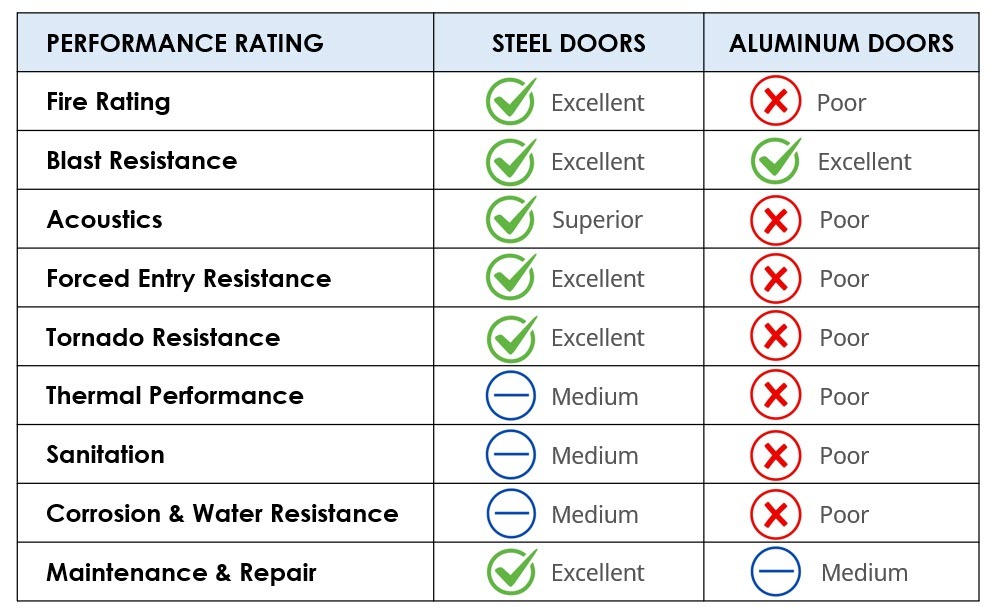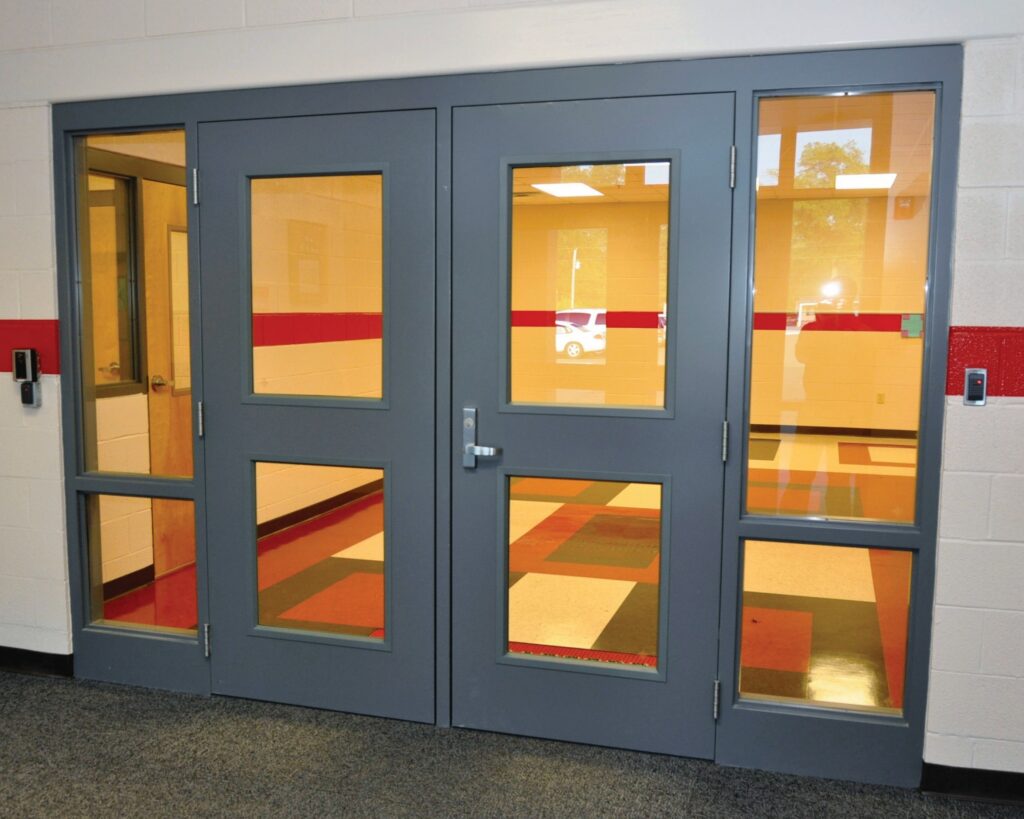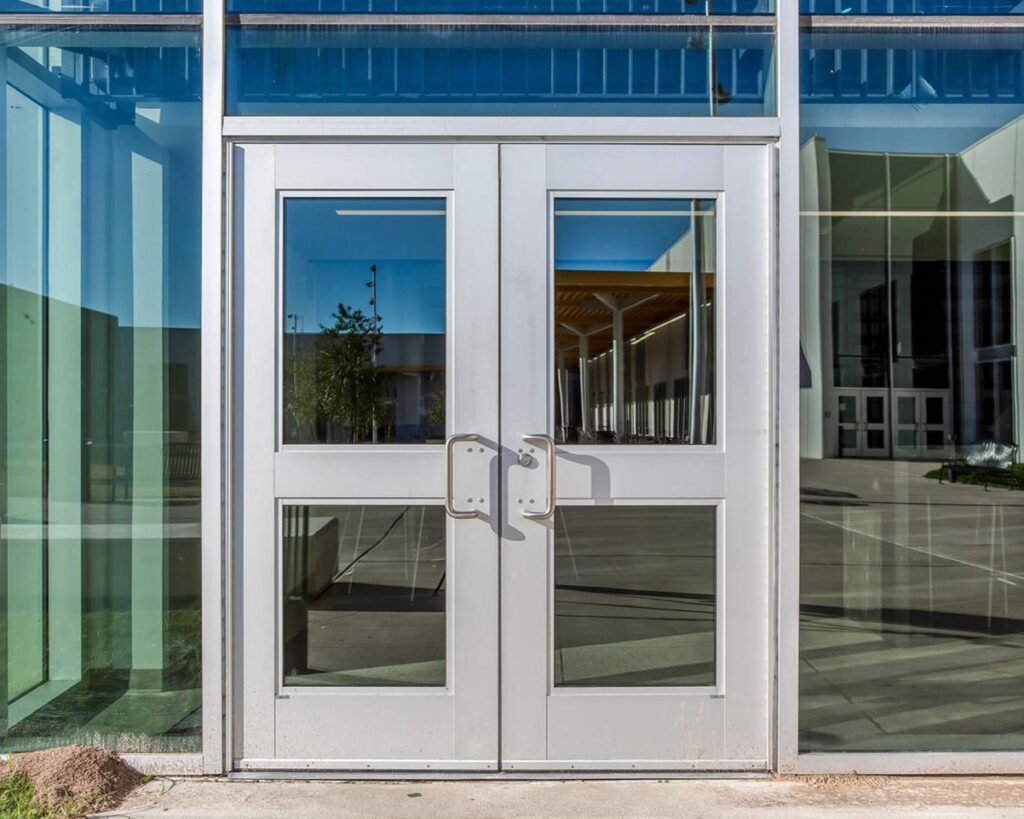Steel vs. Aluminum Doors
A Performance Study
Steel Doors
Aluminum Doors
Which are better performers – steel doors or aluminum doors? Specifiers prefer hollow metal steel doors versus aluminum door options due to the many advantages they offer. Hollow metal will outperform aluminum doors in demanding environments such as fires, tornados, and forced entry. Even when special cores or other techniques are used, they are still unable to match the performance and longevity of hollow metal commercial doors.
The quantitative and qualitative data below is based on extensive research including the use of independent testing agencies, standards organizations, and online information, plus interviews door and frame industry professionals.
Performance characteristics were evaluated using quantitative tests such as measurements by a testing organization and/or to defined industry standards. Qualitative evaluation of performance characteristics was primarily through examination of material attributes and interviews with door and frame experts.
Here are our findings.

Performance Tables
Fire Rating
Blast Resistance
Sound Transmission/Acoustics
Forced Entry Resistance
Tornado Resistance
Thermal Performance
Relative Performance – Sanitation (Anti-microbial Properties)
Relative Performance – Corrosion and Water Resistance
Relative Performance – Maintenance and Repair
Fire Rating

Steel, being a non-combustible material, does not contribute to the spread of fire. Steel is also the only door material that offers a 3-hour fire rating.
Aluminum doors are not as well-suited to fire resistance as steel due to the natural properties of the materials.
Relevant Test Methods/Standards:
- NFPA 80 -Standard for Fire Doors and Other Opening Protectives
- UL 10C – Standard for Positive Pressure Fire Tests of Door Assemblies
CONCLUSION
Steel doors are the sole door material to deliver a 3-hour fire rating and have the best fire rating capabilities.
Blast Resistance

Blast resistant steel door assemblies can pass the common standards for blast resistant openings. Steel doors that are blast resistant are also available in fire or windstorm rated, bullet resistant, and with vision lights.
Aluminum doors also pass each of these blast resistant standards.
Relevant Test Methods/Standards:
- ASTM F2247 – Standard Test Method for Metal Doors Used in Blast Resistant Applications
- ASTM F2927 – Standard Test Method for Door Systems Subject to Airblast Loadings
- ASTM F1642 – Standard Test Method for Glazing and Glazing Systems Subject to Airblast Loadings
CONCLUSION
Blast resistant steel and aluminum door assemblies are both suitable options and capable of passing the common standards for blast resistant openings.
Sound Transmission/Acoustics

Steel offers the highest STC rating of any door material. Single steel acoustic door ratings generally range from STC 32-55 (and up to 66 with highly specialized doors). Steel acoustic doors can achieve a 3-hour fire rating. Vision lights and embossments are available too.
Aluminum doors are not suitable for sound reduction due to the nature of the material.
Relevant Test Methods/Standards:
- ASTM E90 – Standard Test Method for Laboratory Measurement of Airborne Sound Transmission Loss of Building Partitions and Elements
- ASTM E413 – Classification for Rating Sound Insulation
- ASTM E336 – Standard Test Method for Measurement of Airborne Sound Attenuation between Rooms in Buildings
CONCLUSION
Steel doors have the best STC performance characteristics. They are well suited to sound reduction specifications and offer lower lifecycle costs.
Forced Entry Resistance

Steel door assemblies pass the three commonly specified test criteria for forced entry resistance in government and non-government buildings.
Aluminum doors are a softer material than steel and are not suited for forced entry resistance.
Relevant Test Methods/Standards:
- ASTM F1233 – Standard Test Method for Security Glazing Materials and Systems,
- ASTM F3038 – Standard Test Method for Timed Evaluation of Forced-Entry-Resistant Systems
- SD-STD-01.01 – Forced Entry and Ballistic Resistance of Structural Systems
CONCLUSION
Due to its inherent strength and lower lifecycle costs, steel is the optimal and most commonly specified door material for forced entry resistant openings.
Tornado Resistance

Steel doors pass the tornado resistance tests of the two primary standards developers, FEMA and ICC. This includes testing doors at wind speeds up to 250 mph.
Aluminum doors fail to meet the relevant tornado standards and are not listed for tornado resistance.
Relevant Test Methods/Standards:
- FEMA 361 – Safe Rooms for Tornadoes and Hurricanes
- ICC 500 – Standard for the Design and Construction of Storm Shelters
CONCLUSION
Steel is the only door material that is viable for tornado resistant opening applications.
Thermal Performance

Steel doors with a polyurethane core transmit little heat compared to other materials and have a U-Factor of .38 which is just above fiberglass. Steel doors with polystyrene or honeycomb cores also transmit little heat compared to other materials. Hollow metal doors with a steel stiffened core transfer the most heat of the steel core materials with a U-Factor of .61.
Aluminum doors, by far, allow the most heat flow of all the materials. The typical U-Factor of these doors is .83 and the R-Value is 1.2.
Relevant Test Methods/Standards:
- ASTM C1199 – Standard Test Method for Measuring the Steady-State Thermal Transmittance of Fenestration Systems Using Hot Box Methods
- ASTM C1363 – Standard Test Method for Thermal Performance of Building Materials and Envelope Assemblies by Means of a Hot Box Apparatus
- ASTM E1423 – Standard Practice for Determining Steady State Thermal Transmittance of Fenestration Systems
CONCLUSION
Steel’s thermal performance is directly related to its core. Aluminum doors transferred much more heat than steel doors with polyurethane and steel stiffened cores.
Relative Performance – Sanitation (Anti-microbial Properties)

Stainless steel doors with a custom seamless edge have superior anti-microbial properties. They wash easily and sanitize thoroughly, making them a good choice for sanitary environments, such as food handling and medical.
Steel is well suited to environments requiring high levels of sanitation. It washes easily when specified with the appropriate finish and a custom seamless edge. Antimicrobial resin is available for additional protection.
Aluminum doors are porous and not easily sanitized. Very few aluminum doors are available with anti-microbial protection.
CONCLUSION
Other than all glass doors, stainless steel and steel doors have the best sanitation properties. Due to its porous nature, aluminum is difficult to sanitize.
Relative Performance – Corrosion & Water Resistance

Stainless steel doors are commonly specified for environments requiring corrosion or water resistance. Type 316 is required for high salt or high chemical environments, such as coastal applications (salt) and indoor swimming pools.
Steel earned a medium performance rating for corrosion and water resistance. While naturally susceptible to rust, there are cost-effective galvanized coatings and applied finishes are readily available to prevent corrosion in steel doors.
Aluminum is susceptible to corrosion. Although a corrosion-reducing finish may be applied to aluminum doors, aluminum is rarely chosen for corrosive environments.
CONCLUSION
Stainless steel and fiberglass doors have excellent performance in relation to corrosion resistance versus aluminum doors.
Relative Performance – Maintenance & Repair

Steel doors do not crack or dent easily and can often be repaired in the field with body filler or re-welding for a relatively low cost.
Aluminum doors often get dented or scratched. A dented aluminum door cannot be repaired but must be replaced as it cannot be re-anodized.
CONCLUSION
Steel doors have the best price/performance advantage for maintenance and repair compared to aluminum doors.


